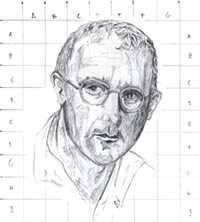Obituary
Dr. Richard Evans Schultes (1915 - 2001)
May 2001
Citation: Erowid, Fire. "Obituary: Dr. Richard Evans Schultes (1915 - 2001)". Erowid Extracts. May 2001;1:2-3.
. . . the first time I met Richard Schultes; it was not what I expected. It was September of 1974; I had come from Berkeley to Cambridge on a Greyhound bus, via a circuitous route that had taken me through the Stropharia fields of Louisiana, through the deep South and on through New York to Boston. I was 23 and on a pilgrimage to find myself, to see the country, to figure out what I was going to do with my life. Mostly, I was on a pilgrimage to see Dr. Richard Evans Schultes, who in my estimation at the time was the world's greatest scientist, and certainly the world's greatest ethnobotanist. Twenty seven years later, on hearing the news that Dr. Schultes had left this world, I found little reason to revise that initial estimation. The world has lost a great man.
-- Dennis McKenna
He was an impeccable scholar and an avid adventurer. His research into the use of plants by indigenous cultures included, from the very beginning, a strong interest in plants with psychoactive properties. Though Dr. Schultes held strongly conservative political beliefs, he was a staunch believer in individual freedom, especially in regards to religion and the use of drugs.
While working in the Harvard Botanical Museum library during his second year in school, Schultes was inspired to enroll in an ethnobotany course. He quickly became interested in the use of peyote by Native American tribes. His professor, the curator of the botanical museum, Oakes Ames, supported him in his decision to write his undergraduate thesis on peyote and funded Schultes's trip to Oklahoma with Weston LaBarre (1936) to study the use of peyote among the Kiowa indians.
"A truly funny, weird, off-beat,
crazy, complex, and ultimately
hilarious character."
-- Ann Shulgin
Schultes soon moved on (1939) to the challenge of verifying the identification of ololiuqui, the Vine of the Serpent. Identified nearly 40 years earlier as Ipomoea sidaefolia (later renamed Turbina corymbosa), there had been recent disagreement amongst botanists about whether that identification was correct, with some claiming that ololiuqui was actually Datura meteloides. Schultes travels took him back to Mexico where he was able to verify the original identification.
 Over the next few years, Dr. Schultes worked extensively with Amazonian tribes, recording and documenting their knowledge of the medicinal and spiritual use of thousands of plants. He collected botanical medicines, hallucinogens, and poisons, identified 14 plant sources of curare, worked with yoco (a local stimulant), gathered data on yage (ayahuasca), and participated in the ritual use of many of the plants he researched.
Over the next few years, Dr. Schultes worked extensively with Amazonian tribes, recording and documenting their knowledge of the medicinal and spiritual use of thousands of plants. He collected botanical medicines, hallucinogens, and poisons, identified 14 plant sources of curare, worked with yoco (a local stimulant), gathered data on yage (ayahuasca), and participated in the ritual use of many of the plants he researched.Schultes was soon caught up in World War II, recruited by the United States to find an Amazonian source for rubber. The U.S. war effort depended on this natural product and 99% of its pre-war supply came from areas of Southeast Asia which had come under Japanese control. For the next 10 years, he devoted much of his time and effort to the development of a disease resistant strain of rubber tree, only to have the project eventually cancelled.
During the 40's and 50's, with only brief trips back to the U.S., he trekked through the Amazon, collecting more than 20,000 specimens of promising plants and gathering information about them from shamans and villagers knowledgeable in their use. After returning to the United States, Schultes took care to warn that the plants of the Amazon, as well as native knowledge of their use, were endangered. It was this belief which, in part, fueled his intensive study of the ethnobotanical knowledge of indigenous people.
"[Dr. Schultes] left us with a heritage of botanical and
pharmacological information that will make him immortal in the
annals of ethnobotany. It is a privilege and a pleasure to have
known him."
-- Sasha Shulgin
His work inspired a new generation of ethnobotanists, including Tim Plowman, who died in 1989, Wade Davis, and Mark Plotkin, who have continued in his footsteps with the study of native peoples and plants.

